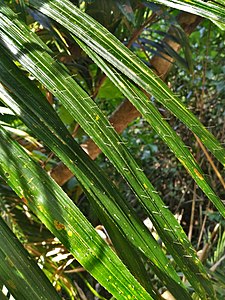Calamus moti
| Yellow lawyer cane | |
|---|---|

| |
| Stem, showing the large spines | |
| Scientific classification | |
| Kingdom: | Plantae |
| Clade: | Tracheophytes |
| Clade: | Angiosperms |
| Clade: | Monocots |
| Clade: | Commelinids |
| Order: | Arecales |
| Family: | Arecaceae |
| Genus: | Calamus |
| Species: | C. moti
|
| Binomial name | |
| Calamus moti | |

| |
Calamus moti is a climbing rainforest plant in the palm family Arecaceae, which is endemic to Queensland. It has a slim flexible stem which does not support the plant, instead it climbs to the forest canopy with the assistance of long tendrils armed with stout recurved hooks.
Description
This is a clustering, climbing palm with stems up to 5 cm (2.0 in) in diameter and 45 m (148 ft) in length, making it the largest of the eight Calamus species found in Australia.[4][5] The leaves are up to 3 m (10 ft) long and are pinnate with 35 to 50 leaflets either side of the rachis. The underside of the rachis has three longitudinal rows of stout recurved hooks.[4][5][6] The leaflets are linear-lanceolate, up to 60 cm (24 in) long by 3 cm (1.2 in) wide, with very fine barbs on their margins[5][6] On the upper surface of each leaflet there are two longitudinal rows, one either side of the central vein, of spines measuring up to 10 mm (0.39 in) long.
The leaf sheaths completely surround the stem and are armed with stout yellow-green spines about 20 mm (0.79 in) long arranged in oblique combs. Flagella armed with stout recurved barbs are produced from the leaf sheath and act as grappling hooks providing support for the flexible stem.[4][5]
On older sections of the stem the fronds and their leaf sheaths fall away, revealing the stem's smooth glossy green surface.
Taxonomy
Calamus moti was first described by Frederick Manson Bailey and published in 1896 in the journal Bulletin of the Department of Agriculture, Brisbane.[7]
Etymology
The genus name Calamus is derived from Ancient Greek κάλαμος (kálamos) and means reed or cane. The species epithet moti is the name for this plant in the language of the Djabugay people of the Barron River.[6][7]
Distribution and habitat
C. moti is endemic to Queensland, ranging from near Cooktown southwards to around Mackay. It grows in well developed rainforest, reaching peak development when close to water courses, and it can be found at elevations from close to sea level to about 1,300 m (4,300 ft).[4][5][6][8]
Ecology and uses
The yellow lawyer cane is the host plant for the white-fringed swift Sabera fuliginosa, a butterfly of the family Hesperiidae, and the fruits are eaten by birds.
Indigenous communities of north Queensland ate the fruits and the young shoots, while the cane from the stem was used for many purposes including axe handles, fish and animal traps, shelters and baskets.[9]
Conservation
This species is listed by the Queensland Department of Environment and Science as least concern.[1] As of 8 April 2022[update], it has not been assessed by the IUCN.
Gallery
-
Leaflets showing needle-like spines on upper leaf surface
-
Flagellum showing sharp recurved barbs
-
Underside of the rachis with stout barbs
-
Habit
References
- ^ a b "Species profile—Calamus moti". Queensland Department of Environment and Science. Queensland Government. March 2022. Retrieved 8 April 2022.
- ^ "Calamus moti". Australian Plant Name Index (APNI). Centre for Plant Biodiversity Research, Australian Government. Retrieved 8 April 2022.
- ^ "Calamus moti". Plants of the World Online. Royal Botanic Gardens, Kew. Retrieved 5 December 2021.
- ^ a b c d Dowe, J.L.; Jones, D.L. (February 2020). "Calamus moti". Flora of Australia. Australian Biological Resources Study, Department of Agriculture, Water and the Environment: Canberra. Retrieved 8 April 2022.
- ^ a b c d e F.A.Zich; B.P.M.Hyland; T.Whiffen; R.A.Kerrigan (2020). "Calamus moti". Australian Tropical Rainforest Plants Edition 8 (RFK8). Centre for Australian National Biodiversity Research (CANBR), Australian Government. Retrieved 8 April 2022.
- ^ a b c d Cooper, Wendy; Cooper, William T. (June 2004). Fruits of the Australian Tropical Rainforest. Clifton Hill, Victoria, Australia: Nokomis Editions. p. 69. ISBN 9780958174213.
- ^ a b Bailey, F.M. (April 1896). "Calamus". Contributions to the Queensland Flora (13): 13. Retrieved 8 April 2022.
- ^ Jones, David L. (1987). Palms in Australia (2 ed.). Chatswood, NSW: Reed Books. pp. 106−107. ISBN 0-7301-0007-3.
- ^ Roberts, John; Fisher, Colin (CJ); Gibson, Roy (1995). A Guide to Traditional Aboriginal Rainforest Plant Use. Mossman, Queensland: Bamanga Bubu Ngadimumku Inc. p. 34. ISBN 0-646-22991-5.
External links
 Data related to Calamus moti at Wikispecies
Data related to Calamus moti at Wikispecies Media related to Calamus moti at Wikimedia Commons
Media related to Calamus moti at Wikimedia Commons- View a map of recorded sightings of Calamus moti at the Australasian Virtual Herbarium
- See images of Calamus moti on Flickriver




